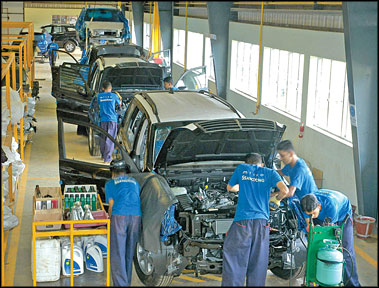|
Asia leading the way:
Heralding a new global economy
Asia is well aware of the challenges and the
countries are taking action on many fronts to fight any future
recession. Asia is now standing tall by strengthened monetary and fiscal
policy frameworks and deepening trade and financial linkages with other
economies.
Anoop Singh
Continued From yesterday
The strengthened policy frameworks and institutions Asia has
developed, particularly over the past decade, stood up well during the
recession and provide a strong foundation for the future. Furthermore,
in many countries in the region, populations are relatively young and
will contribute to burgeoning workforces.
 |
|
Technical
advancement drives Asia forward. File photo |
But by no means will rapid growth in the region continue
automatically. Asia will need to build on its robust policy foundation
with reforms to address the challenges the region still faces in both
the near and the long term. In recent quarters, for example, Asia once
again attracted a surge in capital flows as global investors responded
to the region’s stronger growth prospects. The surge in capital inflows
will need to be carefully managed to prevent overheating in some
economies and to avert an increase in those countries’ vulnerability to
credit and asset price cycles and macroeconomic volatility. However, the
region could also be buffeted if shocks occur in global financial
markets, as such shocks in the past have tended to affect emerging
markets all across the world.
Over the medium term, a key policy challenge for many countries in
Asia is to build on domestic demand, making it a more prominent engine
of growth and relying less on exports. This would also help manage
global imbalances. More important, for many countries, the world
recession has highlighted the unsustainability of tying growth too
heavily to exports, which account on average for more than 40 percent of
Asian growth. With the recovery in advanced economies likely to be
sluggish by historical standards, and their demand likely to remain
below pre-crisis levels for some time, Asia will need to replace the
shortfall in its external demand with a second, domestic source of
demand if it is to sustain strong growth. Private domestic demand has
contributed well to the recovery so far, but for it to continue it must
be nurtured through policy.
The policy measures will vary: some countries will need to increase
consumption; some to sustain or increase investment, especially in
infrastructure; and others must boost productivity in the service
sector-all within the framework of greater trade integration in the
region. Many countries are already improving and broadening the
availability of social services, in addition to developing their
financial sectors, which will help boost domestic demand. Greater
exchange rate flexibility fits into this policy package by helping raise
private consumption and reorient investment toward production for the
domestic economy.
Policy challenges
More broadly, globalization and the reform agenda still have far to
go to bring all countries and populations into the fold. Asia has made
unprecedented progress in poverty reduction in recent decades, with
China alone having pulled some several hundred million people out of
poverty since the launch of its reforms in 1978. Nonetheless, a high
proportion of the world’s poor still live in Asia, and 17 percent of
people in the east Asian and Pacific countries-40 percent in south
Asia-live on less than $1.25 a day. Moreover, the financial crisis has
slowed poverty reduction in the region.
The World Bank estimates 14 million more people in Asia will be
living in poverty in 2010 as a result of the crisis. It is thus more
important than ever to design and implement strategies, including
reforms that enhance growth and strengthen safety nets, to alleviate
endemic poverty in the region. Part of the strategy for low-income
countries must include ways to move from agriculture to manufacturing as
the basis for long-term growth. This will require development of
national and regional infrastructure to reduce transportation costs and
foster the integration of such countries into regional supply chains.
Countries across the region are well aware of the challenges they
face and are taking action on many fronts. Strengthened monetary and
fiscal policy frameworks, efforts at boosting domestic demand, and
deepening trade and financial linkages with other economies have been
the focus of reforms. The infrastructure development to boost the growth
potential of economies is going ahead rapidly in many countries, with
the help of innovative mechanisms such as public-private partnerships.
Barriers to trade, including within the region, are being lifted in ways
that will allow more people to enjoy the gains from international trade,
including by providing new markets and customers for exporters from
smaller economies. Asia is moving ahead rapidly to advance regional
integration more broadly, including through intraregional groupings such
as the ASEAN and ASEAN+3 (including China, Japan, and Korea) and across
regions, such as through the Asia-Pacific Economic Cooperation forum,
with its emphasis on “open regionalism.”
While Asia is growing in both world trade and economic governance,
countries all over the world are interested in Asian successes in
development and managing globalization. The region’s economies offer a
broad range of experiences from countries at various stages of
development and faced with different sets of challenges, and the broader
global economy can draw from them a rich set of lessons. Concluded
Finance & Development, June 2010, Volume 47, Number 2
|



